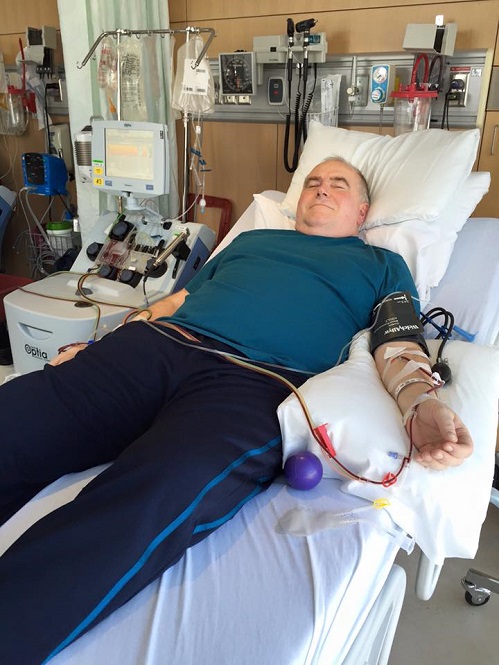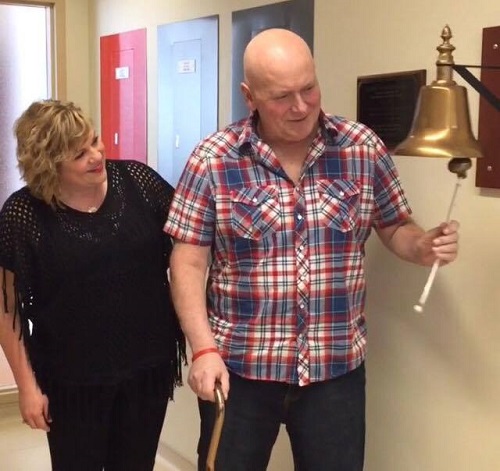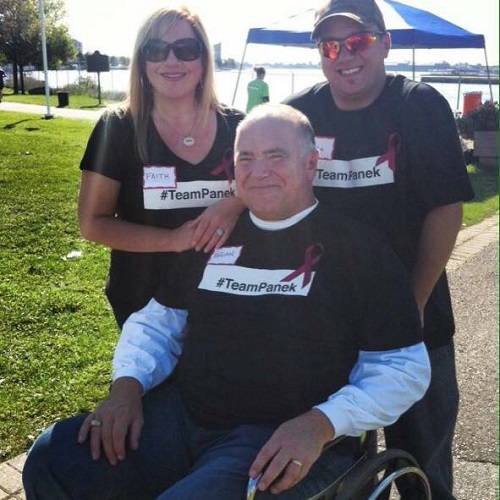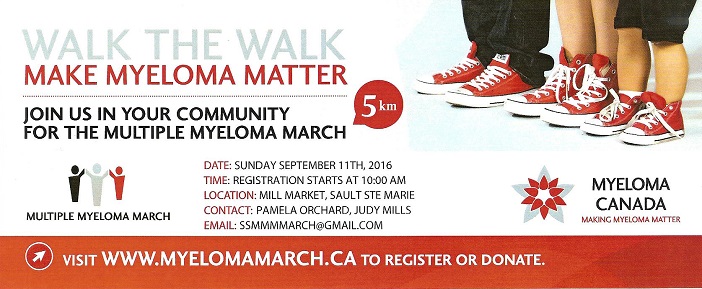In sickness and in health, Brian and Faith Panek, have held true to their vows to one another. Tell me about your love story, I said to the couple. Awww, our love story, Brian said to Faith, reaching across the kitchen table, gently resting his hand on her arm and smiled softly as he caught her eye. Faith looked at him a moment, then giggled.
Twenty-two years ago, the couple met at work and the chemistry was palpable. Four years later they married. “We started a life together and didn’t look back. We’re each other’s best buddy. There’s no one else I’d like to hang out with but him,” smiled Faith.
Brian is a big guy, over 6 feet tall and could be a heavyweight contender. Next to him Faith is tiny and colourful and a spitfire. It’s pretty plain to anyone that Brian adores her.
“I couldn’t have gotten through this without her….without her to talk to, to hold my hand when I needed her to. And I needed her to hold my hand quite a few times. It was a really tough thing to go through,” shared Brian.
On August 4th, 2015, after a rough year of various health concerns -chronic pain throughout his body, a popped rib, sore shoulders, strange lumps, depleted energy, numerous visits to doctors and no answers, Brian almost completely blinded by chest pain, collapsed at work. He was rushed to the hospital via ambulance and Faith and the couple’s son, Matthew, sped to the hospital. Once there, Faith observed Brian’s grey pallor and physical agony and feared that she was preparing to say ‘good-bye’ to her husband.
“The pain was excruciating. I never had anything like that before. It would come on for thirty seconds and then it would pause,” remarked Brian.
“His whole body would cease up – he couldn’t breathe, he couldn’t see. All I could do was lay on the hospital bed with him and rub his head and whisper in his ear ‘you’re ok, just breathe, I’m here honey’. I would just whisper in his ear through those really painful contractions until it passed. And I thought every single time one of those waves of pain came on that this was it. It was awful. I never experienced fear like that- watching someone that you love in so much pain, not knowing what was going to happen from moment to moment,” Faith recalled of that frightening time.
Through all of that exquisite pain Brian was shuttled through the hospital –ECG’s, cat scans and MRI’s. And then finally, hours later, the doctor came in with the news. It wasn’t a heart attack after all. It was cancer.
“He just stared up at the ceiling and I cried and Matthew cried and Brian said to me later, ‘now it all makes sense. It almost isn’t a surprise. Now I know why I’ve been feeling so utterly awful’,” shared Faith as Brian nodded his head.
Numerous lytic lesions -or tumors, including a hole in his right hip the size of an orange, several small lesions on his skull and a lesion on his spine that was so agonizing that the pain of it wrapped around his back and radiated into his chest mimicking a heart attack, confirmed that Brian had cancer but the diagnosis was just the beginning. Finding out what kind of cancer Brian had would be the next mystery to solve.
Brian was immediately placed on a five day round of radiation to alleviate pain and begin shrinking the tumors on Brian’s hips, skull and back. Radiation was followed by 16 weeks of chemotherapy. During these early weeks doctors ran a whack of tests on Brian searching for a primary cancer that they believed were the cause of his tumors.
“They thought the lesions were a secondary cancer,” explained Faith. “They were looking for a primary cancer that caused the lesions. Some cancers like colon cancer or melanoma, can move into the bones. But after all of the tests his body was so healthy, his organs were fine.”
After ruling out many cancers the doctors began narrowing their focus and suspected a relatively rare form of cancer –Multiple Myeloma. Diagnosing multiple myeloma required specific tests including bone marrow aspiration and a 24 hour urine collection. On August 23rd, 2015 Brian and Faith received the official diagnosis of multiple myeloma.
*****
Multiple myeloma is a cancer of the plasma cells. Plasma cells are found in the bone marrow and because plasma cells are found in the blood in the marrow, myeloma is often called blood cancer. The word ‘multiple’ in multiple myeloma is used because malignant cells often affect multiple areas of the bone marrow. When myeloma occurs in the body, plasma cells reproduce uncontrollably, crowding out other types of cells one requires to be healthy. Myeloma is the second most common blood cancer after non-Hodgkin’s lymphoma.
(Source: Myeloma Canada)
*****
As Brian began his treatments he began opening up to Faith about how terrible the pain had been during the year leading up to his diagnosis.
“It was a man thing. I did complain but everybody said I was ‘fine’, ‘rest’, ‘take Tylenol’. I didn’t want to be whiney about it,” admitted Brian.
“After the fact I realized that he had been in such incredible pain that I didn’t know how he made it through his days,” remarked Faith.
When Brian faced the prospect of the uncertainty that came with treatment and the physical endurance that went with it, he paused. “I contemplated initially if I would even go through it or not. You hear so many horror stories about what’s happened to people. I wondered if I should just take medication to keep the pain away,” admitted Brian. “But we decided that we would go this route and see how I do. And it was tough.”
*****
The view of Myeloma has gone from incurable cancer to chronic cancer, with a hope for a cure on the horizon. The current standard of treatment includes: chemotherapy- a personalized chemo suitable to the type of myeloma the patient is experiencing, radiation, stem cell transplants and sometimes surgery.
Stem cell transplant is an important part of treatment. The complicated and lengthy procedure takes a person’s healthy stem cells and then after a round of chemotherapy meant to eradicate any cancer left in the body, the stem cells are re-introduced into that individuals system.
(Source: Myeloma Canada)
*****
Over a seven month period Brian would undergo three types of chemo, surgery to repair the hole in his hip and a stem cell transplant.
“I was foggy a lot of the time,” Brian recalled of the days during his chemotherapy treatments. “They call it ‘chemo brain’. Every time it was time for my pills Faith brought them to me. She brought me meals in my bed. I didn’t want for anything. She took care of me and did an outstanding job. I don’t know how somebody could go through this on their own. You’d screw up your medication for sure.”
At the beginning of his chemo treatments Brian was taking 24 pills a day in addition to other pills to manage his symptoms.
“We’ve had some really dark times, if the walls in our bedroom could talk. We’ve had pain through the nights and sleepless nights and crying and holding each other and being scared,” shared Faith.

Brian hooked up to the stem cell separator in the aphaeresis unit in Ottawa General, February 1, 2016.
Through all of the various treatments Brian underwent, it was the stem cell transplant that was the most challenging.
Having been depleted of an immune system and his stem cells, Brian was required to spend three weeks in bed and for the most part as far away from other people as possible. Family members had to adhere to strict hand washing and unless Brian needed her, which he often did, Faith stayed a safe 10 feet away from the bed.
“It was a really dark and depressing time going through stem cell. New friends that we have made that have gone through stem cell transplant have had the same experience,” shared Faith. “Brian was really ill, vomiting, he had no appetite. He had to go through a regiment of washing his body. Any little thing could be a portal for bacteria. He had to shower in the morning and the evening. And on top of that the shower was tiny and infrastructure issues never raised the temperature above tepid. And the whole time he was hooked up to an IV so we had to cover his arm twice a day with tape and he needed my help with that because he was in such a poor weakened state. Then he had to have two kinds of mouthwash four times a day to keep his mouth healthy. And you just don’t feel like doing all of that when you are sick.”
The day arrived to receive back his own stem cells – a day that it is referred to as a new birthday for stem cell recipients. But that day would be cause for a double celebration. As Brian lay mildly sedated –relaxed, while his stem cells flowed through an IV port back into his body, he and Faith both learned that he was officially in remission. The couple heard the joyful news when Faith overheard a nurse speaking to student observers in the room.
And as customary for patients who achieve remission, a celebration was planned at the hospital for Brian to ‘ring the bell’ – a significant moment that marks the end of active treatment and being cancer free. With multiple myeloma there isn’t a full remission but Brian has made the best recovery possible which is referred to as ‘good partial remission’.
“When I was going through treatments we would see other people ringing the bell,” recalled Brian. “I always thought ‘gee, I wonder if I’ll get to ring the bell’. This whole thing could have gone the opposite way. I could have not been here today.”
“It was a pretty special day,” shared Faith of Brian’s bell ringing ceremony. “We had family and friends come and we did a little speech and then Brian rang the bell. And then we had a party with ice cream cake- his favourite,” laughed Faith looking at Brian. Brain chuckled.
“It was a really happy day, tears and smiles all around,” continued Faith. “It was great. Brian says he couldn’t have done it without me but I think we couldn’t have done it without everybody who stepped up to help us. My mom just lives up the road and I don’t know how many meals she brought to us or how many nights she stayed with me. Matthew would stay here when we had to leave town for medical appointments and look after the dogs and the house. They say it takes a village to raise a child. Well it took a village to support us.”
*****
In 2000, the life expectancy of a myeloma patient was 3-5 years but with more research and development of new treatments, many people are living 10 years or longer. There is no known cause but it is suspected that environmental factors, jobs in agriculture, petroleum workers, pulp and paper employees, cosmetologists and fire fighters have a higher than average risk.
(Source: Myeloma Canada)
*****
Brian is working on recovering his strength and that process can take a while but he’s feeling better than he has in a long time. Exercise and diet are an important part of his lifestyle and in addition to following up with monthly treatments to keep his bones strong –people with myeloma often acquire myeloma bone disease. Brian is also on maintenance chemotherapy in the form of one pill a day.
For Brian and Faith, this year and a half journey has not been without gratitude and neither has it been without new friends. When Brian was diagnosed, a woman named Jill Lang Ward –a survivor of multiple myeloma, contacted the couple and introduced them to the local Myeloma Warriors, also survivors and loved ones. The group embraced the couple and provided experienced support to Brian and Faith.
“It is an interesting group to be part of. What’s brought us together is cancer but it’s not all doom and gloom. We laugh share stories, celebrate each other’s accomplishments and when people relapse, we support each other,” commented Faith.
“It would be nice to be in a group that was about kayaking or mountain climbing but were in this group,” added Brian laughing. “It’s not a group of people that I ever thought I would be a part of. And I’m so glad to know them all.”
Jill Lang Ward was instrumental in finding the first Myeloma Walk in Sault Ste. Marie in 2010. Ten people showed up for the march. Last year over 200 people took part in the annual march and exceeded the City’s fundraising goal. Tragically, Jill passed away this year when myeloma returned. Jill, and Mary Naccarato who also passed away with myeloma this year, will be memorialized at the walk on September 11th. As well, 10 year myeloma survivor, Marion Bently, will be celebrated.
“When we found out there was a walk for myeloma I knew we had to do it. This is our life now,” remarked Faith. “We are an industrial town. There are a lot of industrial and environmental factors that are thought to be the cause of myeloma.”
Brian worked at St. Mary’s Pulp and Paper Mill for seven years and has worked in industry for the majority of his career.
“Being a blue-collar town we are seeing more people with myeloma diagnosis,” added Faith. “So the more people that donate to our annual Myeloma Walk the more help there will be for our City.”
Though confirming the numbers proved to be challenging as myeloma is lumped together with other blood cancers, the local Myeloma Warriors put the number of myeloma incidences in the Sault at a much higher rate than the rest of Ontario.
In Canada and Ontario, the incidence of myeloma is about .015% -in Canada that works out to 2,300 myeloma diagnosis out of 35.6 million people and in Ontario 930 diagnosis out of 13.6 million people. A member of the local myeloma support group mentioned that the Canadian Cancer Society is unable to break out cases of multiple myeloma from other blood diseases locally. Relying on insider information local survivors estimate the number of people affected by myeloma in Sault Ste. Marie at around 50 people out of 75,000 reflecting 6.66% of the population. This number may represent people with active myeloma and those in remission.
“Myeloma doesn’t get the press that other cancers get because myeloma is not as common as other cancers. We want to raise awareness about it. Myeloma is fast moving in research terms of treatment. Five years ago the treatment was different than treatment today and that’s thanks to fundraising for research and clinical trials. Myeloma is a cancer that could have a cure in sight,” remarked Faith.
Today, when Brian wants ice cream – he has ice cream. Life has become about living in the moment and the simple pleasures in life.
“Brian and I have gone through this with a smile on our face because what else are you going to do? Yeah, we had our moments where we holed up in the house and we didn’t want to talk but when those times passed and we were still here, surviving, having a good attitude and finding a reason to be grateful really helped. And we’ve changed our attitude about life. We’re more spontaneous,” shared Faith. “It sounds cliché but you really do have to live your life like every day might be your last because for millions of people with cancer, it just might be. Hug more, laugh more, love more and open your eyes and heart to all the things that are out there for the taking. Don’t sweat the small stuff because at the end of the day those things really don’t matter. This year has made that message abundantly clear to us.”
*****
To register a team or make a donation to Walk the Walk, Make Myeloma Matter: Multiple Myeloma March 2016 click here.
To make a donation to #TeamPanek click here.
For more information about Sault Ste. Marie’s Multiple Myeloma March 2016 email ssmmmmarch@gmail.com
For more information about Multiple Myeloma click here.
(feature image: Brian, Faith and son, Matthew, celebrating remission with ice cream cake and loved ones)






